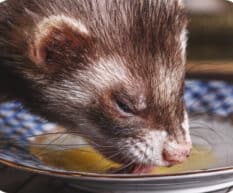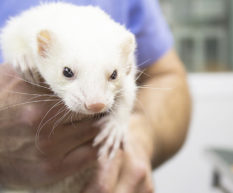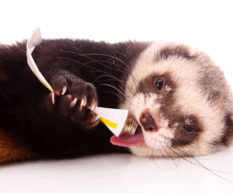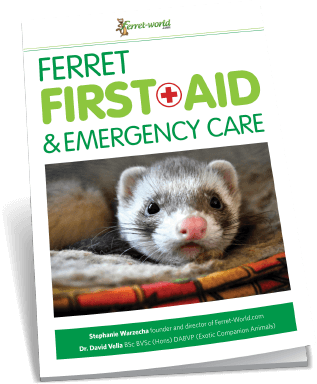Ferret News
Store-Bought vs. Homemade Ferret Food: Which is Better?
By Jazmin "Sunny" Murphy
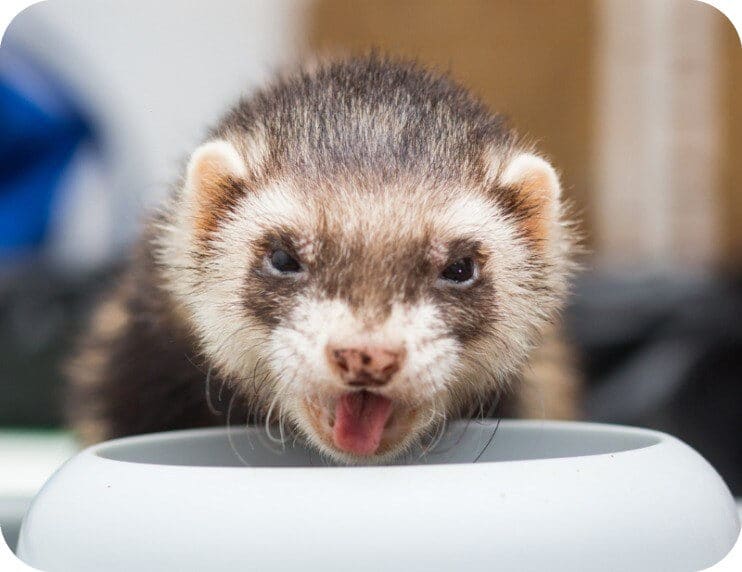
One of the most challenging parts of caring for a ferret is maintaining a healthy diet. It’s tough to decide whether you want to provide kibble or homemade meals, especially since both will keep a ferret reasonably healthy.
Still, you may prefer one option versus another. This review will help you determine which is best for you and your fur-baby.

What should a ferret eat?
Whether you want your ferret to eat store-bought or homemade meals, you’ll need to know what makes up a healthy diet. As long as you fulfill these crucial nutritional needs, your little weasel will be energetic and resistant to common diet-related illnesses.
Scientists have not studied the fundamental components of a well-rounded ferret diet as extensively as they have for dogs and cats. However, researchers have developed an abundance of science-backed guidelines for feeding these pets based on care routines for:
- Ferrets
- Fitch (a cross between the ferret’s ancestor, the European polecat, and the domestic ferret)
- Mink
Judith A. Bell, D.V.M. compiled a wealth of feeding information for all these animals to help ferret owners keep their pets well-fed, specifically by meeting these nutritional “pillars:”
- Constant access to drinking water
- “Palatable, pelleted, or extruded” premium ferret food made of 90 percent dry matter, containing:
- A minimum of 15 percent fat
- 30 percent high-quality meat source protein
- Less than 30 percent carbohydrates
- About 4 Kcal (4,000 calories) of metabolized energy* per gram
*Metabolized energy is the amount of energy that’s available to your ferret’s organs after its body expels the excess in the urine or feces.
Now, you don’t have to follow these standards to the T. However, be careful about veering too far away from ideal ferret nutrition. Bell warns that diets with more carbs and less protein than the criteria above could harm reproductive health and increase your ferret’s susceptibility to various diseases.
Feeding ferrets can be challenging. Bell notes that these pets have “unusually short” digestive tracts. This, along with other anatomical features, means that their bodies process food much more quickly than many other animals, often leading to inadequate digestion. Careful adherence to these guidelines will help you minimize this drawback.

Is store-bought kibble good for ferrets?
Kibble may not always be the best choice for ferret nutrition, but it certainly does the job, especially when paired with natural foods and supplements.
As mentioned earlier, modern ferret diets are based on fitch and mink feeding regimens. For example, pelleted mink diets are made up of 30-35 percent meat-based protein and 20 percent animal fat.
In recent years, producers have added:
- Fresh or frozen meat
- Poultry
- Fish
Since ferrets are relatively new pets (scientific literature refers to the 70s as the “first wave” of domestic ferrets), scientists are still homing in on what works best for a strong diet.
Generally, analyses on various cat and ferret foods* show that breeders find the most success by sticking to these criteria:
- Crude protein (CP): 34.3-39.8 percent
- Crude fat: 20.2-24.8 percent
- Crude fiber: 1.4-2.8 percent
- Moisture: 4.2-10 percent
- Ash: 5.4-7.4 percent
- Carbohydrate: 21.4-27.8 percent
- Metabolizable energy (ME): 3.89-4.58 kcal/g
*This study included analyses of these foods: Marshall Premium Ferret, Purina High Density Ferret, Iams Kitten Food original formula, Totally Ferret, and Science Diet Feline Growth.
Of course, you’ll also want to confirm that your chosen ferret food has plenty of amino acids and vitamins, too.
This diet will keep your ferret fit and satisfied. However, this doesn’t mean your pet will always be lean. In fact, it’s normal for ferrets to get a bit chunky now and then.
“Seasonal obesity” happens because ferrets naturally eat 30 percent more in the winter to keep warm. But don’t worry about it – it’ll scale back its food intake in the following spring and shed that extra weight again.
Adding supplements to your feeding routine
Since ferrets are relatively new pets, scientists and casual ferret owners are still shaping the ideal ferret diet. Often, efforts to determine what works best for these animals’ digestive and reproductive health lead to incorporating supplements like bonemeal and eggs.
You can incorporate nutritional supplements in any diet style, whether your ferret eats kibble or homemade meals.
For instance, probiotics like dried Lactobacillus acidophilus and Lactobacillus plantarum are available in kibbles like Epigen and Evo. These are excellent for providing your ferret with the beneficial bacteria that support gut health.
You may be more familiar with these microorganisms for human wellness. Yet, studies have demonstrated their value for people’s four-legged friends pretty extensively.
In both cases, Lactobacillus bacteria are essential for maintaining a balanced microbial population in the digestive tract. The gut is home to hundreds of species of these invisible helpers that support bodily functions such as:
- Stimulating immune mechanisms
- Combating diseases that affect the intestines
- Fighting food-borne pathogens
- Enhancing nutrient availability
As mentioned, you can find store-bought kibble with probiotics. However, yogurt is an excellent source of these microorganisms if you’re making your ferret’s food at home.

Is homemade ferret food better than store-bought?
Numerous ferret owners prefer a homemade diet, as it gives them more control over their fur-babies’ eating habits. Plus, you can customize your feeding routine whenever necessary, enabling you to adapt on the fly to your pet’s changing needs.
Generally, some of the most common go-to items for feeding ferrets a natural homemade diet include:
- Whole prey (e.g., adult mice)
- Quail
- Guinea pigs
- Blend of organs, bones, meat, and fat
Some ferret owners advise you to be mindful of the prey items’ sizes. The bigger the animal, the more chance your ferret has of experiencing diarrhea. Plus, offering your ferret excessively large prey runs the risk of a messy mealtime. Keep things simple with small things that easily fit in the palm of your hand.
Still, even that can be too much of a hassle for some people. If handling small prey and raw food is too much for you, you might be interested in powder supplements like those offered by Better in the Raw. This way, your ferret will reap many of the benefits of a natural diet without all the gross ingredients.
Many ferret owners are convinced that a natural, homemade diet (which does not always equate to a raw diet) is objectively better than kibble. This is a convincing standpoint, given that these animals are “obligate carnivores.”
This means that, although they can eat plant-based foods, they can only thrive on mostly meat diets. This is because a ferret’s small intestine is relatively short, even though it’s five times longer than its body.
(For more clarity, a cat’s small intestine is 8-10 times its body’s length.)
Food travels through this gut at average rates of 1-3 hours, depending on the ferret’s age, with kits comprising the one-hour digestion speeds.
This rapid process can reduce the body’s efficiency at breaking down foods, making a natural diet better than commercial kibble. Offering your ferret nutrition that it evolved to thrive on may be best for its digestive health.
As you’re gathering more information about feeding your ferret naturally, other ferret owners might suggest that you incorporate milk, canned pumpkin, or eggs.
These are some of the most commonly used natural ingredients in homemade ferret diets. Yet, they aren’t all made equal. Learning more about these foods before developing your feeding routine will ensure you make the healthiest meals for your fur-baby.

Milk
If you decide to make your ferret’s food at home, it may be best to avoid milk, as ferrets have lower concentrations of lactase enzymes than other species. (Lactase is the enzyme responsible for breaking down lactose, a sugar in milk and milk products.)
Many think they can avoid this by opting for goat milk instead, but goat milk contains the same lactose as cow milk.
If you’re adamant about giving your ferret milk, use lactose-free milk instead. (Some disagree with this option, too.)
(Note: It’s interesting that so many ferret owners are now opposed to feeding their pets dairy products. In the early days of their domestication, ferreters and fitch breeders raised their animals on “bread or corn meal soaked with milk.” They’d only get meat about twice weekly. Still, they managed to thrive.)
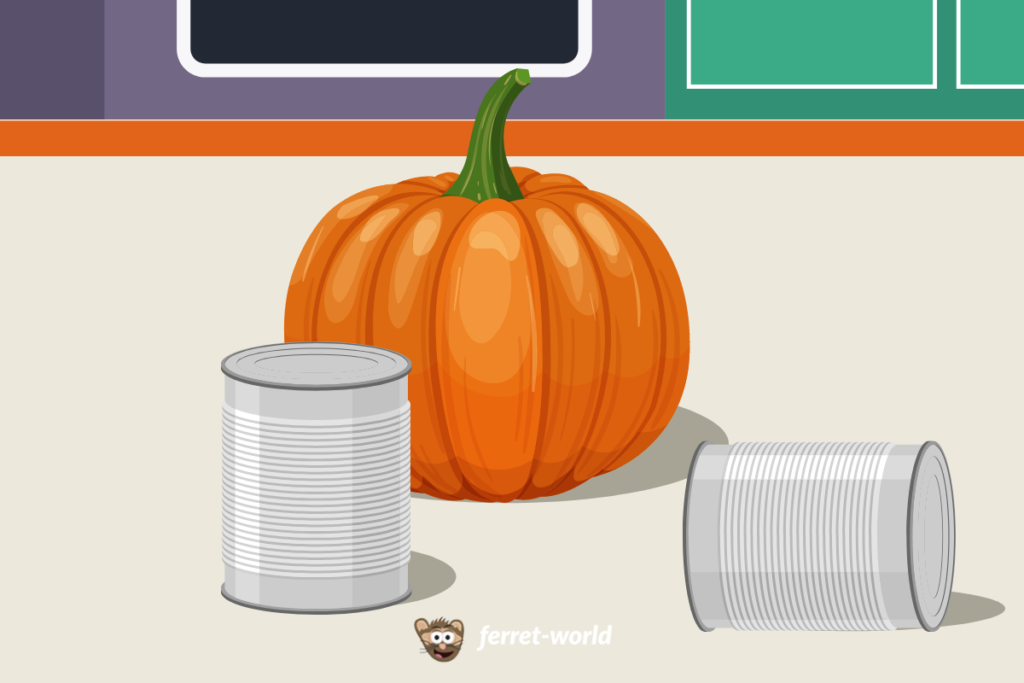
Pumpkin
Too many people overemphasize the importance of canned pumpkin in ferrets’ diets. While this food can certainly help digestive issues, such as dehydration and minor bezoars, it’s not magic. You shouldn’t rely on it for everything.
Most of pumpkin’s value comes from its fiber content. This is what helps your ferret recover from digestive problems. Other than that, canned pumpkin is mostly carbs, so feeding it to your little weasel every day can be pretty damaging to its health.
Now, remember, the ferret community is incredibly diverse. Some people have never even considered using canned pumpkin, but have relied on a natural, raw diet or store-bought kibble instead.
In other cases, ferret owners may only use pumpkin once in a while, noting that it’s especially helpful for hairballs, along with eggs (better for especially bad hairballs).
All this said, don’t be afraid to incorporate canned pumpkin into your ferret’s diet. At the same time, be careful not to overdo it.

Eggs
Eggs are a huge part of the daily ferret diet. Whether you’re preparing a basic breakfast or trying to help your fur-baby out with a hairball, you should always have a chicken or quail egg on hand.
However, some common misconceptions about raw eggs might confuse your efforts in developing a natural feeding regimen at home.
The biggest myth that permeates throughout the ferret community centers around an enzyme called avidin, derived from birds and amphibians. Studies show that avidin is stingy with biotin, keeping your ferret’s organs from using it for nutrition and overall health.
Unfortunately, when people learn that raw eggs contain avidin, they’re afraid that it’ll harm their ferrets’ health. But not to worry!
Raw eggs only contain a small amount of avidin, so it’s not a threat. Plus, raw egg yolks contain impressively high levels of biotin and thiamine, reducing the health risk even more.
(Thiamine is also known as vitamin B1, known for preventing issues with the nervous, digestive, and cardiovascular systems. It also helps manage the movement of electrolytes into and out of muscle and nerve cells.)
The biggest drawback of feeding your ferret raw eggs is the risk of Salmonella. Make sure to buy eggs that are refrigerated and uncracked to minimize the hazard.

Pros and cons of store-bought vs. homemade food
Store-bought food like commercial kibble and homemade meals will both keep your ferret healthy. However, which has the nutritional edge depends on your ferret’s needs and your goals.
For instance, many fitch and ferret breeders are happy to feed their animals kibble, so long as it meets the crucial dietary requirements outlined in the section, Is store-bought kibble good for ferrets?. Their ferrets are pretty healthy on these feeding regimens and have great reproductive success.
Plus, kibble is highly convenient. You don’t need a fridge or refrigerator to store it, and come dinner time, all you have to do is scoop it up or pour it in a bowl.
The mess is minimal compared to homemade meals that may include raw ingredients or require many dishes for preparing meat.
However, kibble can be bad when you opt for cat food as an alternative. Yet, Bell points out that this may be a poor choice, as kibble for cats is “nutritionally inadequate for any stage of ferret life.”
Of course, many ferret owners have got on just fine with cat food. Still, if you don’t have a “minimally stressed pet ferret,” the nutritional deficiencies will pop up rather quickly.
Overall, considering that ferrets are obligate carnivores, a homemade diet may be better for your fur-baby. This is because you have many more opportunities to cater to your weasel’s fundamental nutritional needs without all the artificial preservatives, grains, sugars, and carbs found in many modern kibbles.
Additionally, offering your ferret blends containing bone, organs, and other ingredients will help keep its teeth clean much better than dry kibble.
The biggest drawback of a homemade feeding regimen is that you may have to handle small animals, such as mice, and raw foods. If you’re uncomfortable with this or aren’t prepared to manage such a routine hygienically, it may be best to go with dry kibble.
Store-bought vs. homemade ferret food: Which is best for you?
Ferrets are obligate carnivores. So, whether you decide to provide a commercial kibble or homemade diet, you’ll need to ensure that the menu is full of animal-based protein, along with plenty of fat, carbs, fiber, and metabolized energy.
In either case, you may need supplements for a well-rounded menu for your fur-baby. Probiotics, bone meal, and eggs are popular choices, although they fit more naturally with a homemade diet.
Before you settle on a decision, do your research and talk to your veterinarian to support your ferret’s health as thoroughly as possible.

